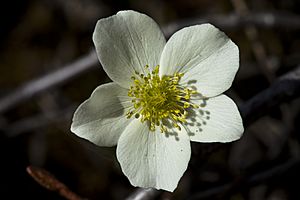Northern anemone facts for kids
Quick facts for kids Northern anemone |
|
|---|---|
 |
|
| Scientific classification | |
| Genus: |
Anemone
|
| Species: |
parviflora
|
The Anemone parviflora, also known as the northern anemone or small-flowered anemone, is a beautiful plant found in North America. It's a type of herbaceous plant, which means it doesn't have a woody stem like a tree or shrub. This plant belongs to the Ranunculaceae family, often called the buttercup family.
Northern anemones usually grow to be about 10 to 30 centimeters (4 to 12 inches) tall. They grow from a very thin underground stem called a rhizome, which is only about 2 millimeters thick.
Discovering the Northern Anemone
This section will help you learn more about the northern anemone, from its appearance to where it likes to live.
What It Looks Like
The northern anemone has different kinds of leaves. Some leaves grow from the base of the plant and have long stalks, called petioles, and are deeply divided into three parts. Other leaves grow directly on the stem without these stalks.
When the plant blooms in late spring to mid-summer, it produces pretty flowers. Each flower usually has 5 or 6 petal-like parts called sepals. These sepals are typically white or a soft bluish color and are about 8 to 13 millimeters (about half an inch) long. Each plant usually has one flower on a single stem, known as a peduncle.
After the flowers, the plant forms fruits. These fruits grow in small, oval-shaped clusters that are about 10 millimeters (less than half an inch) long. The fruits are covered in dense, soft hairs, making them look "woolly." They don't have wings and have small, straight tips, or "beaks," that are 1 to 2.5 millimeters long.
Where It Grows
The northern anemone is native to central and western North America. You can find it mostly in Canada and Alaska. It also grows further south in places like Idaho and even into Utah.
This plant prefers to grow in specific environments. It often thrives on wet, rocky ledges, in open meadows, and along the banks of streams. It especially likes soils that are rich in calcium carbonate, which are known as calcareous soils. This means the soil has a lot of lime or chalk in it.

